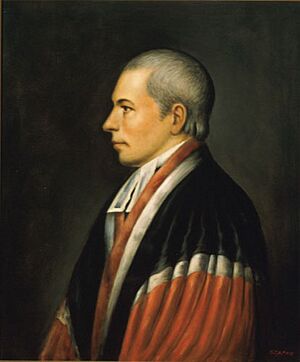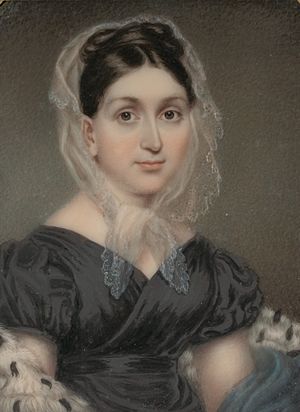William Paterson (judge) facts for kids
Quick facts for kids
William Paterson
|
|
|---|---|
 |
|
| Associate Justice of the Supreme Court of the United States | |
| In office March 11, 1793 – September 9, 1806 |
|
| Nominated by | George Washington |
| Preceded by | Thomas Johnson |
| Succeeded by | Henry Livingston |
| 2nd Governor of New Jersey | |
| In office October 29, 1790 – March 30, 1793 |
|
| Preceded by | Elisha Lawrence (acting) |
| Succeeded by | Thomas Henderson (acting) |
| United States Senator from New Jersey |
|
| In office March 4, 1789 – November 13, 1790 |
|
| Preceded by | Seat established |
| Succeeded by | Philemon Dickinson |
| Attorney General of New Jersey | |
| In office 1776–1783 |
|
| Governor | William Livingston |
| Preceded by | Position established |
| Succeeded by | Joseph Bloomfield |
| Personal details | |
| Born | December 24, 1745 County Antrim, Ireland |
| Died | September 9, 1806 (aged 60) Albany, New York, U.S. |
| Political party | Federalist |
| Spouses |
Cornelia Bell
(m. 1779; died 1783)Euphemia White
(m. 1785) |
| Children | 3 |
| Education | Princeton University (BA, MA) |
| Signature | |
William Paterson (December 24, 1745 – September 9, 1806) was an important American leader. He was a lawyer and a judge. He also signed the U.S. Constitution.
Paterson served as an Associate Justice on the Supreme Court of the United States. He was also the second governor of New Jersey. He is considered one of the Founding Fathers of the United States.
Born in County Antrim, Ireland, Paterson moved to America when he was young. He studied law and became a lawyer in 1768. He helped write the first Constitution of New Jersey in 1776. He also served as the New Jersey Attorney General for many years.
In 1787, he represented New Jersey at the Philadelphia Convention. There, he suggested the New Jersey Plan. This plan aimed for equal representation for all states in Congress. After the Constitution was approved, Paterson became a U.S. Senator. He helped create the federal court system. Later, he became governor of New Jersey. In 1793, President George Washington appointed him to the Supreme Court. He served there until his death in 1806.
Contents
William Paterson's Early Life and Education
William Paterson was born on December 24, 1745, in County Antrim, Ireland. His family moved to America in 1747. They settled in New Castle, Pennsylvania.
When he was 14, Paterson started college at Princeton. After graduating, he studied law with a famous lawyer named Richard Stockton. He became a lawyer in 1768. He also helped start the Cliosophic Society at Princeton. This was a student debate club.
William Paterson's Career in Public Service
Early Political Roles
Paterson was chosen to represent Somerset County in New Jersey's early congresses. He helped write the 1776 New Jersey State Constitution. He then became the first Attorney General of New Jersey. He held this job from 1776 to 1783. This made him one of the state's top lawyers.
In 1787, he went to the Philadelphia Convention. This meeting was held to create a new U.S. Constitution. Paterson suggested the New Jersey Plan. This plan wanted a single legislative body. Each state would have the same number of votes. The final Constitution of the United States used a different idea. It created a two-part Congress. The Senate gives equal votes to each state. The House of Representatives gives votes based on population.
Serving as a United States Senator
Paterson strongly supported a strong national government. He was a member of the Federalist Party. He became one of New Jersey's first U.S. senators. He served from 1789 to 1790.
As a senator, he was on the Senate Judiciary Committee. He helped write the Judiciary Act of 1789. This important law set up the federal court system. The first nine parts of this law are even in his own handwriting.
Governor of New Jersey
In 1790, Paterson became the first person to resign from the U.S. Senate. He did this to become the governor of New Jersey. He took over from William Livingston.
As governor, Paterson focused on legal matters. He organized all the English laws that were used in New Jersey before the American Revolution. He also updated the rules for New Jersey's courts. The state legislature later approved these updates.
Justice of the United States Supreme Court
President George Washington wanted Paterson to join the Supreme Court. He nominated him on February 27, 1793. However, Washington soon realized there was a problem. The law that created the Supreme Court was passed when Paterson was a senator. The Constitution says a person cannot be appointed to a job that was created or had its pay increased during their time in Congress. This is called the Ineligibility Clause.
So, Washington withdrew the nomination. He then nominated Paterson again on March 4, 1793. By this time, Paterson's term as senator had ended. The Senate quickly approved him. He became an associate justice of the U.S. Supreme Court.
On the Supreme Court, Paterson dealt with important cases. He oversaw trials for people accused of treason during the Whiskey Rebellion. This was a protest by farmers in Pennsylvania. They were upset about a federal tax on whiskey. President Washington sent troops to stop the uprising. For the first time, courts had to decide how the Constitution applied to using troops in civil unrest. Paterson always believed that law was more important than governments. This idea is a key part of the Constitution he helped write. He served on the Supreme Court until he passed away in 1806.
William Paterson's Family and Later Life
In 1779, Paterson married Cornelia Bell. They had three children together. Sadly, Cornelia died in 1783, shortly after their only son was born. Their children were:
- Cornelia Bell Paterson (1780–1844)
- Frances Van Paterson (1781–1783)
- William Bell Paterson (1783–1832)
In 1785, he married Euphemia White. She was the sister of Anthony Walton White.
Death and Burial
William Paterson died on September 9, 1806, at age 60. He passed away from injuries he got in a coach accident in 1803. He was visiting his daughter Cornelia in Albany, New York. He was buried in the Van Rensselaer family vault. Later, his remains were moved to Albany Rural Cemetery in Menands, New York.
Legacy and Honors
Both the city of Paterson, New Jersey, and William Paterson University are named after him. This honors his important contributions to the state and the country.
Images for kids
See also
- Demographics of the Supreme Court of the United States
- List of justices of the Supreme Court of the United States
- List of United States Supreme Court justices by time in office
- United States Supreme Court cases during the Jay, Rutledge and Ellsworth Courts
- United States Supreme Court cases during the Marshall Court
- U.S. Constitution, floor leader in Convention.
- List of United States senators born outside the United States
- List of U.S. state governors born outside the United States



